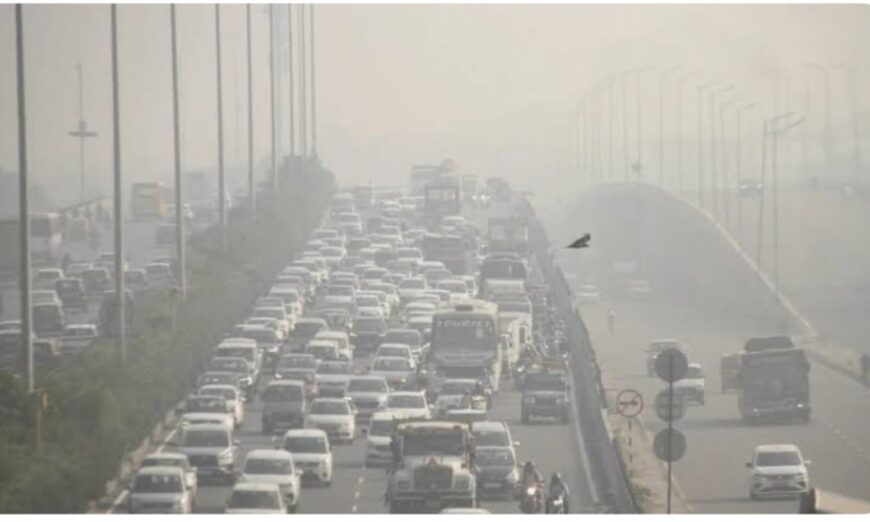Delhi woke up enveloped in a thick layer of smog on Tuesday morning, just hours after Diwali celebrations lit up the sky with fireworks.
Air quality across the National Capital Region (NCR) nosedived overnight, at 5:30 a.m. on Tuesday, Delhi recorded an average Air Quality Index (AQI) of 346, placing most parts of the city firmly in the red zone.
A video shared by PTI showed the iconic India Gate and Kartavya Path barely visible through the haze, highlighting how sharply visibility had dropped in the city’s heart.
As Delhi lit up with Diwali celebrations on Monday night, the city’s air turned alarmingly toxic. Despite the Supreme Court allowing only a two-hour window for bursting green firecrackers, between 8 pm and 10 pm, fireworks continued well past the permitted time.
The prolonged celebrations led to a sudden and steep rise in pollution levels across the national capital.
On Tuesday morning, the air quality continued to be “very poor”. The average Delhi AQI (air quality index) observed at 5.30 am on Tuesday stood at 346, with most areas in the red zone.
By late evening on Monday, most air quality monitoring stations across Delhi showed red alerts, indicating ‘very poor’ to ‘severe’ pollution levels. Around 10 pm, data from the Central Pollution Control Board (CPCB) showed that 36 out of 38 monitoring stations had entered the red zone.
The city’s overall Air Quality Index (AQI) stood at 344, which falls under the ‘very poor’ category. Notably, four key stations reported ‘severe’ readings above 400.
Some of the city’s most affected areas included Wazirpur (AQI 423), Dwarka (417), Ashok Vihar (404), and Anand Vihar (404), according to the CPCB’s SAMEER app.
Delhi’s 24-hour average AQI, recorded at 4 pm, was 345, higher than Sunday’s reading of 326. In the afternoon, 31 stations had already reported ‘very poor’ air quality, while three had moved to the ‘severe’ zone.
According to the officials, the situation could worsen further, with pollution levels expected to stay in the ‘severe’ category on Tuesday and Wednesday, News18 reported.
The CPCB classifies AQI levels between 301-400 as ‘very poor’ and 401-500 as ‘severe’. Anything above 400 is considered hazardous for public health, especially for children, the elderly, and those with respiratory illnesses.
Toxic air grips NCR too: Noida AQI today
The AQI in NCR region also remained alarming on Tuesday morning. Data from the private air quality tracker aqi.in showed that at 7 am, Noida’s AQI stood at 412, indicating ‘severe’ pollution levels.
Greater Noida recorded an AQI of 390, while Ghaziabad was at 412. In Faridabad, the AQI was also 412, and Gurugram read 402.
Air Quality Index: Who is to be blamed for the pollution?
Data from the Decision Support System (DSS) revealed that transport emissions contributed 15.6 per cent to the city’s pollution on Monday, while industries accounted for 23.3 per cent. Other local sources such as open burning and construction dust added to the mix.
The Commission for Air Quality Management (CAQM) had already put Stage II of the Graded Response Action Plan (GRAP) in place across Delhi-NCR on Sunday, based on forecasts from the India Meteorological Department (IMD) and the Indian Institute of Tropical Meteorology (IITM).
Despite these measures, the air quality worsened rapidly as fireworks filled the sky. Earlier this month, the Supreme Court had permitted the sale and use of green firecrackers only in specific time slots, but the lack of strict enforcement led to yet another post-Diwali pollution spike in Delhi.
Morning visuals on Tuesday reveal Akshardham, partially obscured by haze. Stage II (GRAP-2) measures are in effect across Delhi-NCR.
Data showed that 36 out of 38 monitoring stations recorded pollution levels in the ‘red zone’, indicating ‘very poor’ to ‘severe’ air quality across the city.

